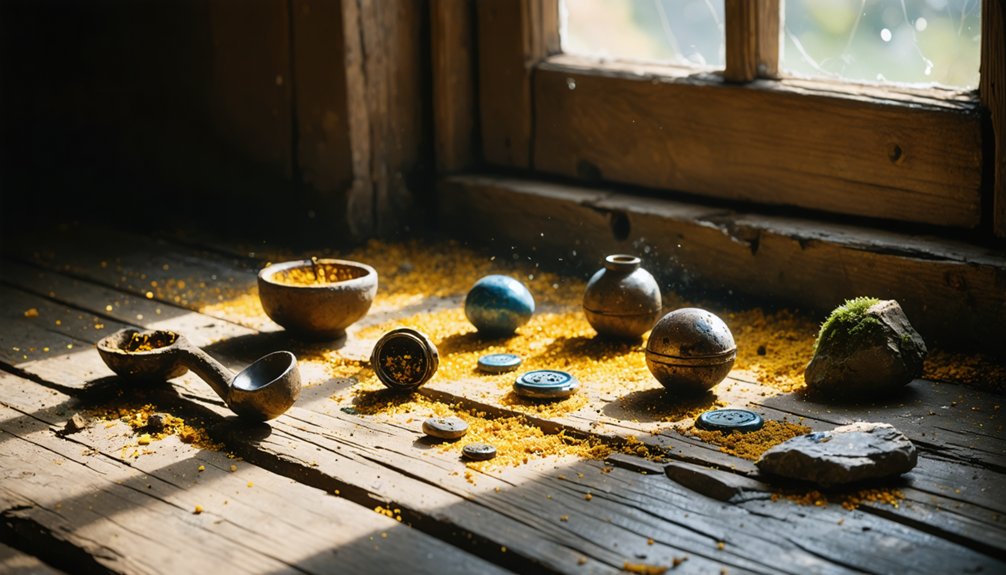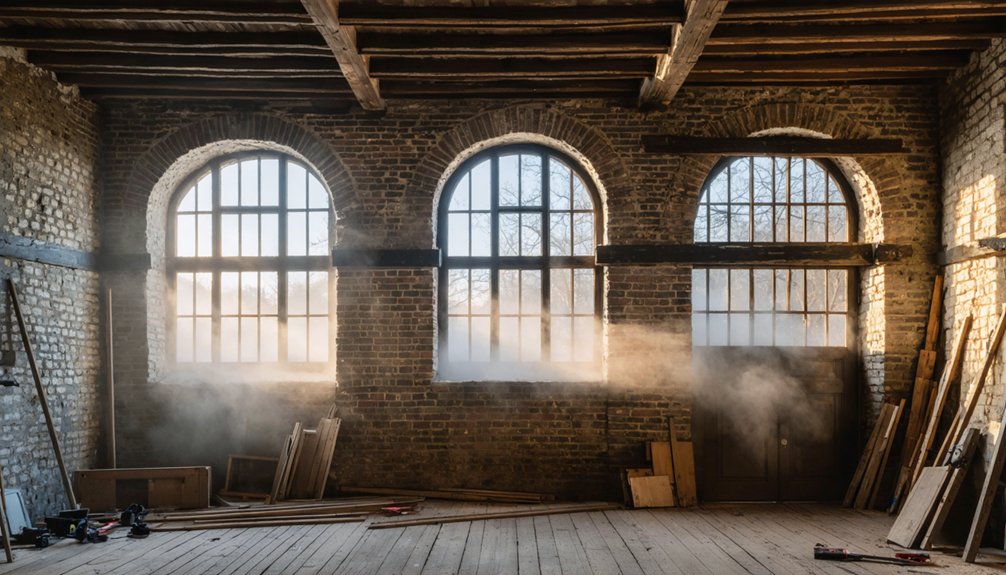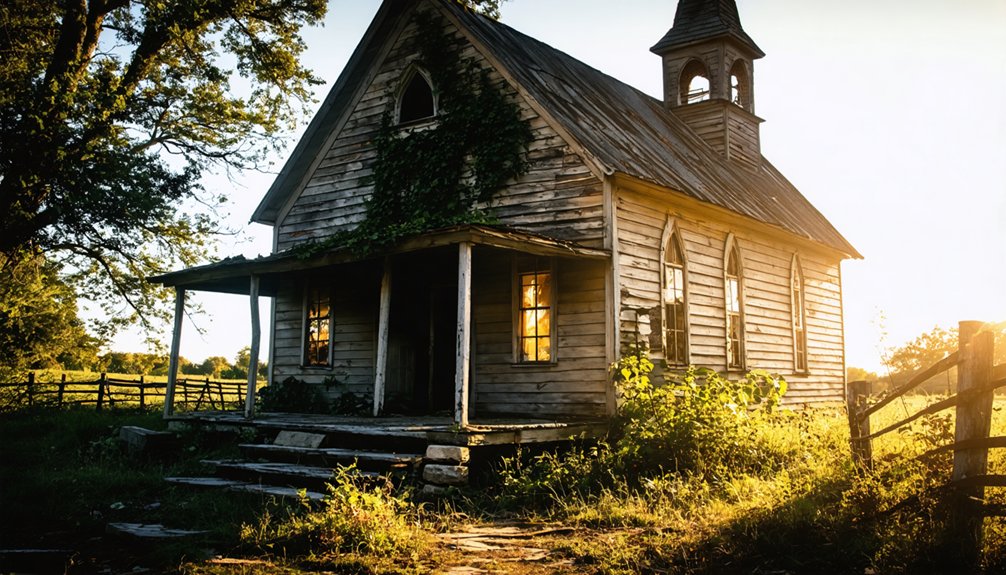America’s forgotten settlements offer tangible connections to our past. You’ll find Bodie’s preserved wooden structures in California’s mountains, Montana’s Garnet with its frontier saloons, and Utah’s Harrisburg ruins. Alaska’s Kennecott showcases industrial copper mining, while Colorado’s Dearfield represents African American homesteading resilience. Tennessee’s Elkmont preserves logging history, and archaeological sites reveal colonial foundations. These ghost towns stand frozen in time, their silent structures awaiting your exploration.
Key Takeaways
- Wooden structures in Bodie, California are preserved in “arrested decay,” showcasing authentic colonial architecture and mining-era buildings.
- Orson Adams House in Harrisburg, Utah features Greek Revival architecture with smooth-cut native sandstone walls from the 1860s.
- Garnet, Montana’s thirteen preserved drinking establishments reflect the social organization of early American frontier settlements.
- The 14-story mill in Kennecott, Alaska stands as evidence of early industrial development that processed 4.6 million tons of ore.
- Dearfield, Colorado contains remains of America’s most successful Black farming community, showcasing African American homesteading resilience.
The Gold Rush Legacy: Preserved Streets of Bodie, California
Nestled at an elevation of 8,379 feet in the Sierra Nevada Mountains, Bodie, California stands as America’s most authentic preserved Gold Rush ghost town, offering visitors an unparalleled window into the boom-and-bust cycle that characterized Western mining settlements.
Founded in 1859 after W.S. Bodey’s gold discovery, the town exploded in population after 1876 when the Standard Company struck a profitable vein.
You’ll find nearly 200 original wooden structures maintained in “arrested decay,” showcasing authentic Bodie architecture from saloons to the impressive Standard Mill.
Walking these streets, you’re surrounded by the remnants of a once-thriving economy that produced over $38 million in gold mining revenue.
At its height in 1880, the town earned a reputation for its dangerous nature, becoming known for the infamous phrase Badman from Bodie.
The town eventually fell into decline as gold reserves depleted, leaving behind the ghost town visitors explore today.
Since becoming a National Historic Landmark in 1961, Bodie preserves the raw reality of frontier life without sanitizing its lawless reputation.
Garnet’s Hidden Saloons: Montana’s Best-Preserved Mining Town
When you visit Garnet’s remarkably preserved saloon district, you’ll encounter the remnants of thirteen drinking establishments that once formed the social backbone of this Montana mining community.
Kelley’s Saloon stands as the most prominent example, with its two-story structure that physically segregated male patrons gambling below from female company above.
The Bureau of Land Management‘s conservation efforts have maintained these saloons alongside mining equipment, furnishings, and personal artifacts that offer an authentic glimpse into frontier life between the 1890s and 1940s. Visitors today can still see evidence of the devastating fire in 1912 that contributed significantly to the town’s decline. Unlike typical mining boom towns, Garnet was known for its family-oriented community, which influenced the town’s unique character even in its entertainment venues.
Frontier Bar Scene
The social heart of Garnet, Montana during its mining heyday revealed itself in the remarkable concentration of thirteen to fourteen saloons that populated this frontier settlement.
These establishments weren’t merely drinking holes but complex social institutions where you’d find the town’s pulse beating strongest.
The typical saloon architecture featured two-story structures with distinct functional divisions: drinking and gambling on the main floor, while the upper level hosted separate entertainment for women. Kelleys Saloon exemplified this layout as a prominent two-story establishment where men gathered downstairs while women were entertained above.
Gambling culture thrived as miners sought fortune beyond the mines, engaging in card games and other diversions.
Mrs. Kelley’s establishment stood out for its female proprietorship—unusual for the era.
Similar to the Vigilantes’ justice administered in Virginia City, these saloons established their own social order in the absence of formal law enforcement.
When fire ravaged Garnet in 1912, these essential social hubs weren’t rebuilt, eventually transforming into the weathered remnants you can explore today as silent witnesses to frontier life.
Preserved Mining Artifacts
Remnants of Garnet’s mining prosperity lie scattered throughout Montana’s best-preserved ghost town, offering visitors tangible connections to its gold-rush heyday.
You’ll find the Nancy Hanks Mine positioned just above the main street, once a major contributor to the town’s $950,000 gold production—equivalent to $71 million today. Foundations of stamp mills reveal early mining techniques while weathered equipment illustrates the technological capabilities of 19th-century prospectors.
The BLM’s minimalist preservation approach maintains these historical artifacts in their authentic state, focusing on stabilization rather than reconstruction. During its peak in January 1898, the town boasted a population of 1,000 residents who supported the thriving mining economy.
Explore original log cabins built without foundations during the 1895 boom, many later repurposed as needs changed. The town’s thirteen saloons served as social hubs where miners gathered after grueling workdays underground. Despite winter damage and vandalism over decades, these preserved structures stand as educational resources, allowing you to experience Montana’s gold rush era through tangible remnants of frontier ingenuity.
Desert Remnants: The Abandoned Settlements of Harrisburg, Utah
When you explore Harrisburg’s ruins, you’ll witness how devastating floods forced early Mormon pioneers to repeatedly relocate their settlement until the Virgin River permanently altered their agricultural viability.
The enduring drought that followed these inundations created an unsustainable environment for farming families, accelerating their exodus from this once-promising desert community by the 1890s.
Among the scattered stone foundations split by Interstate 15, the Adams House remains as the sole fully restored structure, standing as a symbol of the brief period of pioneer optimism before environmental hardships rendered the settlement uninhabitable. Visitors can see the remaining stone cottages that housed the original residents until 1869 when multiple crises led to the town’s abandonment. This site benefits from WikiProject Ghost towns documentation efforts that help preserve its historical significance through accurate geographical coordinates and well-sourced historical information.
Floods Reshape Pioneer Lives
While original settlers of Harrisburg, Utah had selected their site with hopes of agricultural prosperity in 1859, catastrophic flooding reshaped their community’s trajectory from its earliest days.
You’ll find that within their first year, these pioneers faced immediate flood resilience challenges when rising waters forced them to abandon Harrisville entirely and relocate to higher ground along Quail Creek.
The settlers’ struggle against nature continued relentlessly. In 1862, another major flood submerged their original settlement, and recurring inundations persistently undermined their agricultural efforts and damaged infrastructure.
Despite constructing a five-mile irrigation canal, the community couldn’t overcome these pioneer challenges. The floods, combined with grasshopper plagues and security threats, ultimately led to Harrisburg’s abandonment by 1895—a settlement that once housed 128 resilient souls reduced to stone ruins bisected by Interstate 15.
Persistent Drought Drives Exodus
Despite the settlers’ determined efforts to establish a permanent community in Harrisburg, the region’s persistent drought conditions ultimately sealed the settlement’s fate beyond what any irrigation system could remedy.
You’ll find that these unforgiving environmental pressures intensified around 1869, when devastating grasshopper plagues destroyed already struggling crops.
The settlement abandonment accelerated as drought impacts combined with repeated flooding events created an impossible agricultural equation.
Where 128 residents once built stone houses and cultivated the land, the harsh desert environment gradually reclaimed its territory.
By 1895, Harrisburg stood empty—a reflection of freedom’s harsh price in unforgiving landscapes.
The exodus reflected not just environmental surrender but also weariness from Native American conflicts, as settlers ultimately chose liberty elsewhere over persistent struggle in an increasingly hostile environment.
Adams House Stands Alone
A solitary sentinel amid the desert’s reclamation, the Orson Adams House remains the last intact structure of Harrisburg’s once-thriving pioneer settlement. Built between 1862-1865, this two-room sandstone building showcases Greek Revival architecture against the dramatic red cliffs backdrop.
You’ll notice the smooth-cut native sandstone walls and surrounding stone fences—tangible evidence of pioneer resilience in Utah’s harsh desert environment. The architectural significance extends beyond aesthetics; the root cellar and strategic hillside positioning demonstrate practical adaptations to challenging conditions faced by Mormon settlers.
Now preserved by the Bureau of Land Management, this singular survivor stands in stark contrast to the collapsed ruins of neighboring homesteads.
As you explore the site, the Adams House offers a rare, authentic window into colonial settlement life—a preserved embodiment of those who confronted environmental hardships while expanding westward.
Kennecott’s Copper Kingdom: Alaska’s Industrial Ghost Town

In the remote Wrangell Mountains of Alaska, one of America’s most significant industrial ghost towns stands as a tribute to early 20th-century mining innovation and corporate ambition.
When you visit Kennecott today, you’re walking through a remarkable chapter of American industrial history. After Warner and Smith discovered extraordinarily pure copper ore in 1900, the Guggenheim-Morgan partnership invested over $25 million to develop what became the world’s richest concentration of copper.
The 14-story mill and surrounding buildings showcase mining technology that processed 4.6 million tons of ore between 1911 and 1938, yielding over $200 million (equivalent to $2.5 billion today). Unlike typical rough mining camps, Kennecott offered unprecedented amenities for workers and their families.
Marvel of industrial innovation delivering astronomical wealth while providing workers uncharacteristic comfort in Alaska’s rugged wilderness.
When the copper finally ran out, this once-thriving community transformed overnight into the preserved ghost town you can explore today.
Dearfield’s Prairie Dreams: Colorado’s African American Homesteading Past
While Alaska’s Kennecott represents America’s industrial mining ambition, a lesser-known but equally significant settlement emerged on Colorado’s eastern plains at the turn of the twentieth century.
Founded in 1910 by Oliver Toussaint Jackson, Dearfield exemplified Black agriculture resilience amid systemic oppression. This 320-acre townsite, surrounded by 19,000 acres of farmland, flourished with 300-700 residents who built a self-sustaining community complete with homes, churches, and businesses.
Dearfield became America’s most successful Black farming community, where residents achieved the rare distinction of owning their land.
The Dust Bowl and Great Depression ultimately devastated Dearfield’s agricultural economy. Now preserved as a ghost town with original structures intact, Dearfield’s legacy continues through preservation efforts.
This remarkable experiment in independence stands as a testament to African American homesteading perseverance against overwhelming odds.
Lost in the Smokies: Elkmont’s Forgotten Logging Community

Hidden beneath the lush canopy of Great Smoky Mountains National Park, Elkmont’s forgotten logging community represents a vanished chapter of Appalachian industrial history.
You’ll find remnants of a once-thriving town established in the mid-1800s, where Robert Trentham’s early settlement evolved into a vibrant logging hub under William Townsend’s Little River Lumber Company.
Elkmont’s logging legacy transformed the area from wilderness to the county’s second-largest town by 1920, complete with railroad infrastructure that later fueled tourism development.
After logging ceased in 1926, the community pivoted to a vacation destination with the establishment of the Appalachian Club.
Today, the abandoned cabins and crumbling foundations stand as evidence to this transformation, with the National Park Service preserving 19 historic structures in the Elkmont Historic District—silent witnesses to the area’s industrial past.
Unearthed Foundations: Archaeological Discoveries in Colonial Ghost Towns
Archaeological excavations across America’s colonial ghost towns have revealed intricate foundation networks that tell compelling stories about early European settlements.
You’ll find that excavation techniques like ground-penetrating radar and radar tomography have uncovered subsurface patterns suggesting buried structures and human activity areas without disturbing the soil.
Through meticulous artifact analysis, researchers have identified 16th-century English pottery fragments, sea-voyage jars, and writing tablets that point to European residence rather than merely trade.
At Site X near the Chowan River, evidence suggests Roanoke colonists established inland settlements—a theory supported by over 275 pounds of recovered Indian pottery alongside dozens of English artifacts.
Modern archaeological approaches focus on common colonists’ lives, using slot trenches and postmold patterns to reconstruct building foundations and settlement layouts, providing windows into early American colonial experiences.
Frequently Asked Questions
How Dangerous Is It to Explore These Abandoned Ghost Towns?
Exploration carries significant risks requiring safety precautions. You’ll face structural instabilities, environmental hazards like lead contamination, legal consequences of trespassing, and health dangers from mold and contaminated groundwater.
Are Any of These Sites Believed to Be Haunted?
You’ll find a mountain of ghostly legends at all these locations. Each site features well-documented spectral sightings, with Bodie’s alleged curse, St. Elmo’s Annabelle Stark apparition, and Centralia’s eerie smoke-filled landscape.
Can Visitors Take Artifacts Found at These Ghost Towns?
No, you can’t legally remove artifacts from ghost towns. Federal and state legal regulations prohibit unauthorized collection, prioritizing artifact preservation over personal ownership. Violations may result in significant penalties.
What’s the Best Season to Photograph These Historic Sites?
Autumn provides ideal conditions with warm colors contrasting against ruins, while winter offers dramatic low-angle light that accentuates architectural textures. You’ll find both seasons minimize tourist interference, maximizing your photographic freedom.
How Did Residents Communicate Between Isolated Ghost Towns Before Telephones?
How isolated were these settlements truly? You’d find residents relying on horseback couriers, letter writing between postal stations, committees of correspondence, and occasionally smoke signals when indigenous communication methods were adopted.
References
- https://www.geotab.com/ghost-towns/
- https://en.wikipedia.org/wiki/Wikipedia:WikiProject_Ghost_towns
- https://www.christywanders.com/2024/08/top-ghost-towns-for-history-buffs.html
- https://en.wikipedia.org/wiki/Ghost_town
- https://www.mythfolks.com/haunted-us-ghost-towns
- https://albiongould.com/ghost-towns-to-visit-in-the-states/
- https://whakestudios.com/us-ghost-towns/
- https://en.wikipedia.org/wiki/Lists_of_ghost_towns_in_the_United_States
- https://www.bodiehistory.com
- https://www.travelandtourworld.com/news/article/us-gold-rush-ghost-town-bodie-transforms-from-thriving-boomtown-to-haunting-historic-landmark/



